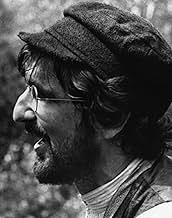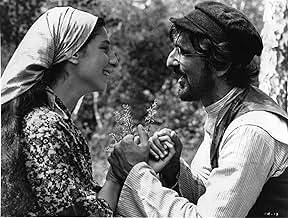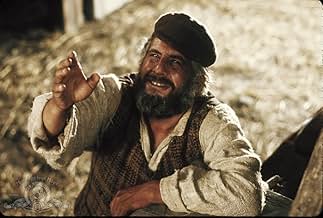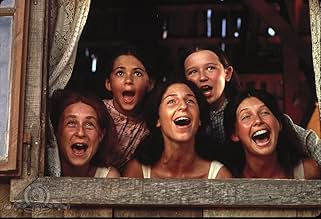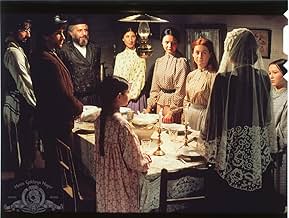रूस में पुर्वक्रान्तिकारी, एक यहूदी किसान अपनी तीन बेटियों के साथ शादी कराने के लिए संघर्ष करते हैं, जिस समय शामी भावनाओं के विरूद्द जाने में गाँव को खतरा है.रूस में पुर्वक्रान्तिकारी, एक यहूदी किसान अपनी तीन बेटियों के साथ शादी कराने के लिए संघर्ष करते हैं, जिस समय शामी भावनाओं के विरूद्द जाने में गाँव को खतरा है.रूस में पुर्वक्रान्तिकारी, एक यहूदी किसान अपनी तीन बेटियों के साथ शादी कराने के लिए संघर्ष करते हैं, जिस समय शामी भावनाओं के विरूद्द जाने में गाँव को खतरा है.
- 3 ऑस्कर जीते
- 10 जीत और कुल 14 नामांकन
Paul Michael Glaser
- Perchik
- (as Michael Glaser)
Ray Lovelock
- Fyedka
- (as Raymond Lovelock)
कहानी
क्या आपको पता है
- ट्रिवियाFinal film of Norma Crane; she was suffering from breast cancer during production, and died less than 2 years later.
- गूफ़During the first few shots of the crowd holding candles on their way to the wedding, the sun changes positions above the horizon. (But as such indicates the length in time of the journey by foot, which could be intentional, in which case the slow melting of candles might be a goof in its own right.)
- क्रेज़ी क्रेडिटTopol and the cast sing "Tradition" without any opening credits rolling. At the end of the number, the fiddler standing on the left of the screen launches into an extensive solo while the opening credits roll on the right of the screen.
- इसके अलावा अन्य वर्जनOriginally released at 181 minutes (with an intermission); later trimmed for 1979 reissue to 149 minutes.
- कनेक्शनEdited into 5 Second Movies: Fiddler on the Roof (2008)
- साउंडट्रैकTradition
(1964) (uncredited)
Music by Jerry Bock
Lyrics by Sheldon Harnick
Performed by Topol and Chorus in the pre-credits sequence
फीचर्ड रिव्यू
Epic in plot, setting and length, Fiddler on the Roof tells a surprisingly tight and focused story that has "universal" poignancy--in a nutshell, it's about trying to maintain strong cultural traditions and identity in the face of a continually changing world, partially fueled by the youth, that doesn't necessarily share the culture's values or self-assessment of worth.
The plot is based on short stories written around the turn of the 20th Century by Sholom Aleichem, who was often called the "Russian Mark Twain". Aleichem wrote a number of works based on his character Tevye the Milkman, who has seven daughters (in the film, this was pared down to five). They live in the fictional Jewish shtetl ("village", or "little town or city") of Anatevka in Tsarist Russia in the early 1900s. The stories are "slice of life" stuff. A lot of attention is paid to Tevye's daughters and their potential suitors. One of the prominent conflicts with tradition is a struggle with arranged marriages versus marriages for love, but of course, being set in pre-revolutionary Russia, there are also political changes brewing, some of which have a profound affect on Tevye's family and village.
Aleichem's Tevye stories were first turned into a Broadway musical, which began its initial run in 1964 with Zero Mostel as Tevye. Producer and director Norman Jewison, who had had success with films like In the Heat of the Night (1967) and The Thomas Crown Affair (1968), and who was experienced as a producer and director for musical-oriented televisions shows, including "Your Hit Parade" (1950) and "The Judy Garland Show" (1960), was asked around early 1970 by United Artists to helm the Fiddler on the Roof film. To their surprise, Jewison wasn't Jewish. He got the gig anyway, and in August 1970, began an arduous shoot--much of it done in a small village in Yugoslavia that refused to cooperate when it came to weather (Jewison couldn't get the snow he wanted). He ended up getting a lot of pressure because the shoot went over time and over budget--this was one of the most expensive films of its time, which was an era of economic woes for Hollywood--but of course we know it paid off in the end.
Zero Mostel was out as Tevye, and Israeli actor Chaim Topol, or just "Topol", was in, based largely on Jewison seeing him in the role of Tevye in the London stage production of Fiddler. Jewison had said that he was shooting for more realism in the film, as opposed to what he saw as a kind of campy humor in the Broadway production.
In my eyes, Jewison ended up with a bit of both approaches in his finished film, but that's all for the better. Sequences like the opening "Tradition" montage are hilarious in their juxtaposition of a grand operatic attitude and the rhythmic coordination of cleaning fish, hanging slabs of meat, and so on. Yes, a lot of Fiddler is very realistic, but it's equally humorous and surrealistic most of the time.
The realism is largely thanks to the authentic settings, the fabulous production and costume design, and of course, the superb performances. The humor is a factor of the above with that Mark Twain-ish aspect of Aleichem's stories and the fine script by Joseph Stine.
The surrealism comes largely by way of the cinematography. Some of the visual sense is reminiscent of Marc Chagall's early work and his later, nostalgic depictions of his native Russia, and in fact, the image of the fiddler on the roof comes directly from a Chagall painting. Jewison saw the fiddler as a cross between a metaphor for the Jewish spirit (and this is explained in more detail via a few lines of dialogue in the film) and an actual physical manifestation of a spirit. However we interpret the fiddler, the shots of him and his presence in the film are certainly poetic. Jewison also gives us some fabulous, surreal, wide landscape shots, such as those of agricultural fields and the beautiful "wasteland" in which the train tracks are set. There are a few scenes set on the banks of a river, overlooked by a bridge, that are reminiscent of particular Van Gogh paintings. And as a more subtle bit of surrealism, Jewison had cinematographer Oswald Morris shoot much of the film though a woman's stocking--the mesh is very clearly visible in some exterior shots. Of course, there are also a couple more surrealistic touches in the plot, my favorite being the Tevye's Dream sequence, which features traditionalist Jewish zombies in an operatic attitude.
A musical couldn't be a 10 without great music, and Fiddler on the Roof has it. The songs are a marvelous melding of traditional Russian folk melodies, with appropriate twinges of Orientalism and the expected Broadway sound, but maybe leaning a bit closer to a modern opera. From that description, you might think that the music would be a mess, but all of the songs are inventive and catchy. They are seamlessly melded with the drama, furthering the narrative as they should. The choreography is excellent and it is well shot by Jewison. And Isaac Stern's violin solos are outstanding, of course.
Fiddler on the Roof takes an investment of time--it's three hours long, but it's well worth it. It offers great drama, great music, great humor and great tragedy in a beautiful package--you'll laugh, you'll cry, you'll sing, and you just might break a leg trying to dance.
The plot is based on short stories written around the turn of the 20th Century by Sholom Aleichem, who was often called the "Russian Mark Twain". Aleichem wrote a number of works based on his character Tevye the Milkman, who has seven daughters (in the film, this was pared down to five). They live in the fictional Jewish shtetl ("village", or "little town or city") of Anatevka in Tsarist Russia in the early 1900s. The stories are "slice of life" stuff. A lot of attention is paid to Tevye's daughters and their potential suitors. One of the prominent conflicts with tradition is a struggle with arranged marriages versus marriages for love, but of course, being set in pre-revolutionary Russia, there are also political changes brewing, some of which have a profound affect on Tevye's family and village.
Aleichem's Tevye stories were first turned into a Broadway musical, which began its initial run in 1964 with Zero Mostel as Tevye. Producer and director Norman Jewison, who had had success with films like In the Heat of the Night (1967) and The Thomas Crown Affair (1968), and who was experienced as a producer and director for musical-oriented televisions shows, including "Your Hit Parade" (1950) and "The Judy Garland Show" (1960), was asked around early 1970 by United Artists to helm the Fiddler on the Roof film. To their surprise, Jewison wasn't Jewish. He got the gig anyway, and in August 1970, began an arduous shoot--much of it done in a small village in Yugoslavia that refused to cooperate when it came to weather (Jewison couldn't get the snow he wanted). He ended up getting a lot of pressure because the shoot went over time and over budget--this was one of the most expensive films of its time, which was an era of economic woes for Hollywood--but of course we know it paid off in the end.
Zero Mostel was out as Tevye, and Israeli actor Chaim Topol, or just "Topol", was in, based largely on Jewison seeing him in the role of Tevye in the London stage production of Fiddler. Jewison had said that he was shooting for more realism in the film, as opposed to what he saw as a kind of campy humor in the Broadway production.
In my eyes, Jewison ended up with a bit of both approaches in his finished film, but that's all for the better. Sequences like the opening "Tradition" montage are hilarious in their juxtaposition of a grand operatic attitude and the rhythmic coordination of cleaning fish, hanging slabs of meat, and so on. Yes, a lot of Fiddler is very realistic, but it's equally humorous and surrealistic most of the time.
The realism is largely thanks to the authentic settings, the fabulous production and costume design, and of course, the superb performances. The humor is a factor of the above with that Mark Twain-ish aspect of Aleichem's stories and the fine script by Joseph Stine.
The surrealism comes largely by way of the cinematography. Some of the visual sense is reminiscent of Marc Chagall's early work and his later, nostalgic depictions of his native Russia, and in fact, the image of the fiddler on the roof comes directly from a Chagall painting. Jewison saw the fiddler as a cross between a metaphor for the Jewish spirit (and this is explained in more detail via a few lines of dialogue in the film) and an actual physical manifestation of a spirit. However we interpret the fiddler, the shots of him and his presence in the film are certainly poetic. Jewison also gives us some fabulous, surreal, wide landscape shots, such as those of agricultural fields and the beautiful "wasteland" in which the train tracks are set. There are a few scenes set on the banks of a river, overlooked by a bridge, that are reminiscent of particular Van Gogh paintings. And as a more subtle bit of surrealism, Jewison had cinematographer Oswald Morris shoot much of the film though a woman's stocking--the mesh is very clearly visible in some exterior shots. Of course, there are also a couple more surrealistic touches in the plot, my favorite being the Tevye's Dream sequence, which features traditionalist Jewish zombies in an operatic attitude.
A musical couldn't be a 10 without great music, and Fiddler on the Roof has it. The songs are a marvelous melding of traditional Russian folk melodies, with appropriate twinges of Orientalism and the expected Broadway sound, but maybe leaning a bit closer to a modern opera. From that description, you might think that the music would be a mess, but all of the songs are inventive and catchy. They are seamlessly melded with the drama, furthering the narrative as they should. The choreography is excellent and it is well shot by Jewison. And Isaac Stern's violin solos are outstanding, of course.
Fiddler on the Roof takes an investment of time--it's three hours long, but it's well worth it. It offers great drama, great music, great humor and great tragedy in a beautiful package--you'll laugh, you'll cry, you'll sing, and you just might break a leg trying to dance.
- BrandtSponseller
- 4 जून 2005
- परमालिंक
टॉप पसंद
रेटिंग देने के लिए साइन-इन करें और वैयक्तिकृत सुझावों के लिए वॉचलिस्ट करें
विवरण
बॉक्स ऑफ़िस
- बजट
- $90,00,000(अनुमानित)
- US और कनाडा में सकल
- $1,04,04,330
- US और कनाडा में पहले सप्ताह में कुल कमाई
- $17,26,942
- 11 नव॰ 1979
- दुनिया भर में सकल
- $1,04,07,890
- चलने की अवधि3 घंटे 1 मिनट
- रंग
- पक्ष अनुपात
- 2.35 : 1
इस पेज में योगदान दें
किसी बदलाव का सुझाव दें या अनुपलब्ध कॉन्टेंट जोड़ें







